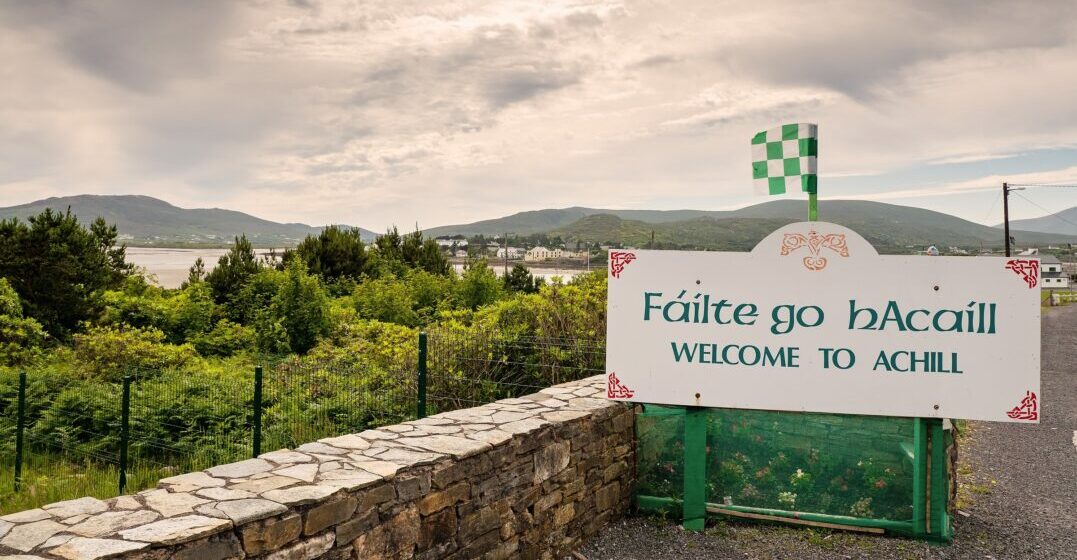by Laura Jones
Updated on September 18, 2024
If you think it’s English, you’d be right, or at least half right. Ireland has two official languages: English and Irish (also known as Gaelic). If you’ve been to Ireland, you might already have figured this out after seeing the bilingual road signs. The variety of English spoken on the Emerald Isle is specifically known as Hiberno-English. It aligns with British English in anything revolving around grammar and spelling, but influences of the Scots language can be heard in its pronunciation and various accents.
While English is the language used by the majority of the population, if you’re lucky you might be able to hear Irish spoken in more rural areas. Ready to learn a little more about Ireland’s official languages? Let’s start with Irish.
Irish, or Gaeilge, is one of Ireland’s official languages. The question of how many people speak Gaelic is difficult to answer. In the 2016 census, 1.7% of the population said that they speak Irish daily but just under 40% of people said that they could speak some Irish. Until the 18th century, Irish was the majority of the population’s first language but it declined as the English took over the country. Ireland definitely isn’t a bilingual country but, like in countries such as Canada, many signs are in Irish and English.
Where people live in Ireland has an impact on how likely they are to speak the language. Parts of the west of Ireland are called the Gaeltacht, a term for areas of the country where Irish is still a community language. If you want to have the highest chances of hearing Irish spoken, you’ll want to go to Galway, Donegal, Mayo and Kerry. In Galway County, 49% of people said they spoke some Irish; this was the highest percentage in the country.
If you are heading to Ireland, it’s a great idea to learn a couple of words in Gaeilge. Try these ones out:
Dia duit: Hello
Slán: Goodbye
Sláinte: Cheers!
(The Irish love of drinking is just a stereotype but it’s worth learning this phrase for when you visit some of the excellent pubs on the island.)
English is the other official language of Ireland and it’s the language that’s used by the vast majority of the population. The version of English spoken in Ireland is called Hiberno-English and it’s a collection of a few dialects that blend the English and Irish languages to create something quite unique. (It’s not just the accent that’s different in Irish-English!)
Irish slang is also different from other countries. If someone tells you something is grand, they mean it’s good. If they tell you something is awful good, they mean it’s fantastic. When you meet someone, they might ask, How are ye keepin’? which is a way to say hello and, if you hear someone calling a child bold, it’s not a good thing. This means naughty. You might want to watch some Irish films or TV shows before you go to get more familiar with the dialects.
While Ireland only has two official languages, the country is very diverse and if you visit, you’re likely to hear a ton of other languages. The 2016 census showed that there were 72 different languages spoken in Ireland. Apart from English and Irish, the most common were Polish, with almost 136,000 speakers and French, with nearly 55,000 speakers. Among non-European languages, Chinese and Arabic were the most common in Ireland. There’s also Irish Sign Language of course, which is actually closer to French Sign Language than British.
If you’re wondering about Northern Ireland, there is no official language there but the majority of the population speaks English. If you travel to Northern Ireland, you might hear Ullans, Ulster Scottish. Around 8% of the population can speak at least a little of this language, which is closely related to Scots.
Of the two official languages in Ireland, visitors are most likely to speak English, which is just fine. But if you’re planning a holiday to the Emerald Isle, learning a few words in Irish will go a long way to making the locals smile. Just make sure to check your pronunciation first as it’s got quite different rules to English!
